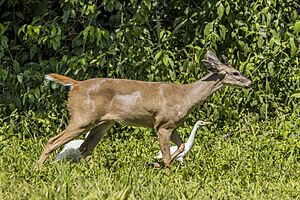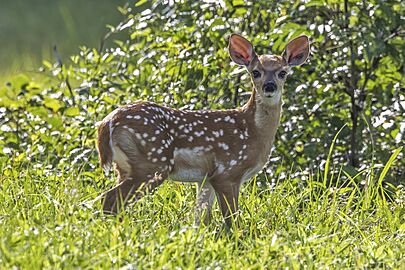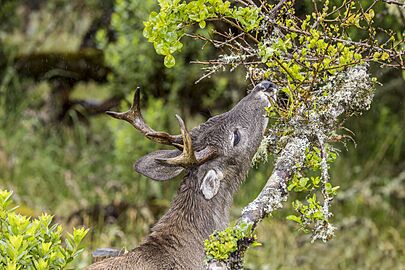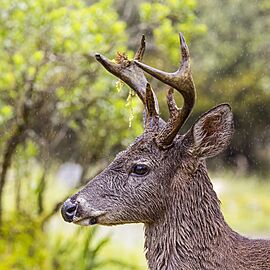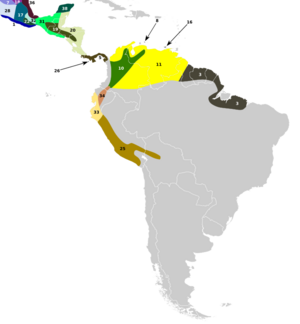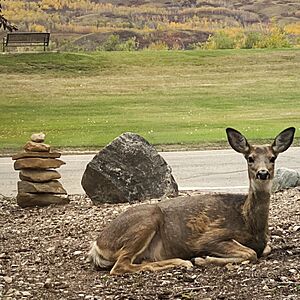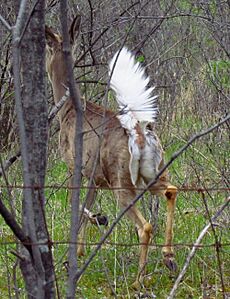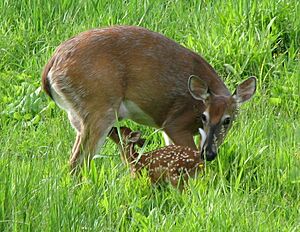White-tailed deer facts for kids
Quick facts for kids White-tailed deer |
|
|---|---|
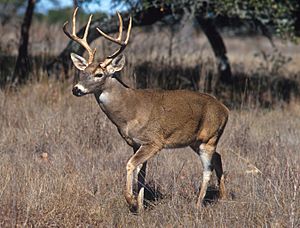 |
|
| Male (buck or stag) | |
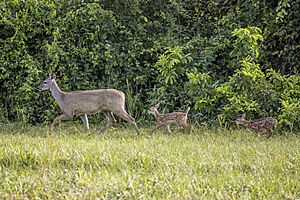 |
|
| Female (doe) O. v. nelsoni with juveniles (fawns) | |
| Conservation status | |
| Scientific classification | |
| Subspecies | |
|
38, see text |
|
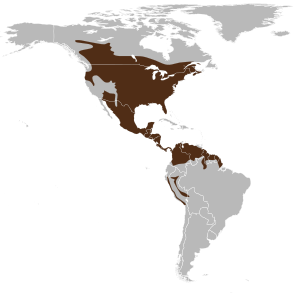 |
|
| White-tailed deer range map | |
| Synonyms | |
|
The white-tailed deer (Odocoileus virginianus) is a medium-sized species of deer. People also call it the whitetail or Virginia deer. It lives naturally in North America, Central America, and South America. You can find it as far south as Peru and Bolivia, especially in the high Andes mountains.
This deer has also been brought to other places. These include New Zealand, islands in the Caribbean like Cuba and Puerto Rico, and some countries in Europe. In the Americas, it is the most common wild hoofed animal.
In North America, white-tailed deer live mostly east of the Rocky Mountains. They are also found in parts of Arizona and Mexico. They usually don't live where mule deer are common, except near rivers and in lower mountain areas.
Texas has the most white-tailed deer in the U.S., with about 5.3 million. Many deer also live in states like Michigan, Minnesota, and Wisconsin. As more land is used for farming, the deer have spread further north into places like Yukon. This is because farming creates more food for them. White-tailed deer are most active at dawn and dusk. This means they like to move around when the sun is rising or setting.
Contents
Deer Families: Understanding Taxonomy
Taxonomy is how scientists group living things. Some scientists have tried to divide white-tailed deer into many different types, called subspecies. They looked at how the deer looked different.
However, studies of their DNA suggest there are fewer subspecies than once thought. For example, the Key deer in Florida and the Columbian white-tailed deer are both endangered. The Virginia white-tail is one of the most common subspecies in the United States.
White-tailed deer in Central and South America also have many subspecies. It's hard to study them because of overhunting and a lack of protection.
White-tailed Deer Subspecies
There are 26 known subspecies of white-tailed deer. Seventeen of these live in North America.
North and Central America
Some examples of North American subspecies include:
- O. v. borealis – the northern white-tailed deer, which is one of the largest.
- O. v. clavium – the Key deer, found in the Florida Keys.
- O. v. dacotensis – the Dakota white-tailed deer, found in the northern plains.
- O. v. leucurus – the Columbian white-tailed deer, found in Oregon and Washington.
- O. v. texanus – the Texas white-tailed deer.
-
O. v. nemoralis, female, Costa Rica
-
O. v. nelsoni, fawn about two weeks old, Belize
South America
Some examples of South American subspecies include:
- O. v. cariacou – found in French Guiana and northern Brazil.
- O. v. goudotii – found in the Andes mountains of Colombia and Venezuela.
- O. v. peruvianus – found in Peru and possibly Bolivia.
Appearance and Size
The white-tailed deer's fur is reddish-brown in spring and summer. It changes to grey-brown in fall and winter. You can easily spot them by the white underside of their tail. When they feel scared, they raise their tail to warn other deer that danger is near.
Older deer often have longer snouts and greyer fur. This can help you guess their age. There's a special group of white-tailed deer in New York that are completely white. They are not albino, but their fur is naturally white. The former Seneca Army Depot in New York has the largest group of these white deer.
White-tailed deer have eyes that help them see well at night. They can also see colors during the day, but not as many as humans. They are very good at spotting movement, especially in low light.
Size and Weight
The size of white-tailed deer changes a lot depending on where they live. Deer living farther from the equator are usually bigger. Male deer, called bucks, in North America typically weigh between 150 and 300 pounds (68 to 136 kg). Some very large bucks in the northern areas have weighed over 400 pounds (181 kg).
Female deer, called does, usually weigh from 90 to 200 pounds (40 to 90 kg). Deer in tropical areas or the Florida Keys are much smaller. They average 77 to 110 pounds (35 to 50 kg). The total length of a deer, including its tail, can be from 37 to 87 inches (95 to 220 cm). Their shoulder height is about 21 to 47 inches (53 to 120 cm).
Deer have two-color vision, seeing mostly blues and yellows. This means they don't see oranges and reds very well. This is why hunters wear bright orange. It helps humans see each other, but deer don't notice the color as much.
Antlers
Male deer grow new antlers every year. Antlers start growing in late spring. They are covered with a soft, fuzzy skin called velvet. This velvet has many blood vessels that help the antlers grow.
Antlers can be "typical" or "atypical." Typical antlers are even on both sides, with points growing straight up. Atypical antlers are uneven, and their points can grow in different directions. The size and shape of antlers depend on how old the deer is, what it eats, and its genetics. Healthy, well-fed deer can grow large antlers even when they are young.
Bucks lose their antlers from late December to February, after the breeding season.
Deer Life and Environment
White-tailed deer can live in many different places. They are very adaptable. The largest deer live in cooler parts of North America. These include the northern white-tailed deer and the Dakota white-tailed deer. The smallest deer are found in the Florida Keys and tropical lowlands.
Even though we often think of deer living in forests, they can also live in open grasslands and savannas. Deer in these open areas often have larger antlers and tails. The Texas white-tailed deer, for example, lives in the savannas of Texas and Mexico. They have very impressive antlers.
In some western areas, white-tailed deer live in the same places as mule deer. Sometimes, they even have hybrid offspring. White-tailed deer are usually shy and hide more than other large animals like moose or elk in national parks.
Central and South American white-tailed deer prefer dry forests and grasslands. They usually avoid very dense, wet forests. In the Andes mountains, the deer keep their grey coats because of the cold weather.
White-tailed deer were brought to Europe in the 19th century. They were introduced to Finland in 1935 and have done very well there. Their population has grown to about 109,000 deer, spreading through northern Scandinavia.
What White-tailed Deer Eat
White-tailed deer eat a lot of different foods. They commonly eat plants like legumes, leaves, and grasses. They also enjoy acorns, fruits, and corn. Their special stomachs allow them to eat things humans can't, like some mushrooms and poison ivy. Their diet changes with the seasons, depending on what food is available.
They can also eat hay and white clover found near farms. While they mostly eat plants, they have been seen eating small animals like nesting birds or mice if they need extra food. If they need more minerals like calcium, they might even chew on bones from dead animals. A grown deer can eat about 2,000 pounds (907 kg) of plants each year!
Deer thrive in suburban areas because there's less danger from predators and lots of food in gardens and parks. They like "edges," which are places where different types of plants meet, offering both food and cover.
Deer are ruminants, meaning they have a four-chambered stomach. This allows them to eat quickly and then digest their food later in a safe place. They chew their food again, called "cud," to help with digestion.
Who Hunts White-tailed Deer
Many animals hunt white-tailed deer. The main predators are wolves, cougars, American alligators, jaguars, and humans. These predators often hunt young or sick deer, which helps keep the deer population healthy. They can also hunt healthy adult deer.
Smaller predators like bobcats, Canada lynx, grizzly and American black bears, and coyotes mostly hunt fawns (baby deer). Bears might attack adult deer sometimes. Lynx, coyotes, and wolverines are more likely to hunt adult deer when the deer are weak from harsh winter weather. Many scavengers, like New World vultures and foxes, eat deer that have already died.
When deer sense danger, they often breathe heavily and run away. The sound they make, called "blowing," warns other deer. As they run, their white tails flash, which also warns other deer, especially fawns. Most predators try to surprise deer. Cats like cougars try to suffocate the deer by biting its throat. Wolves and coyotes bite the deer's legs and sides until they can kill it. Alligators grab deer when they come to drink water and drag them in.
In eastern North America, many of the deer's natural predators are gone. This has led to too many deer in some areas. Coyotes are often the main non-human predator there. Sometimes, black bears also hunt deer. There have been talks about bringing back wolves and cougars to help control deer populations, but this is difficult because of human settlements.
Deer that are hunted a lot by humans learn to run away quickly. White-tailed deer are very fast. They can sprint up to 40 miles (64 km) per hour and keep a speed of 30 miles (48 km) per hour for several miles. They can also jump 9 feet (2.7 m) high and 30 feet (9.1 m) forward. If a deer feels very threatened, it might charge at a person or predator, using its antlers or head to fight.
How Deer Change Forests
In some parts of eastern North America, many deer can eat so many plants that it changes the forest. They eat wildflowers, young trees, and shrubs. This can lead to more grasses and ferns that deer don't like to eat. These changes can also affect the types of birds that live in the forest.
However, deer also play a role in keeping the forest healthy. In areas with a medium number of deer, their eating habits can help different types of plants grow. This happens by reducing plants that grow too much and by adding nutrients to the soil.
Scientists are also worried that many deer can help invasive plants spread. These are plants that are not native to the area and can harm the local ecosystem. Studies have shown that where there are more deer, invasive plants grow faster, while native plants decrease because deer prefer to eat them.
Deer Population
The number of white-tailed deer in North America has gone down by several million since 2000. However, as of 2017, their population is considered healthy. It is about the same as it was before Europeans came to the continent.
Deer Behavior and Life Cycle
Reproduction and Life Cycle
Female deer, called does, usually give birth to one to three spotted babies, called fawns. This happens in late spring, usually in May or June. Fawns lose their spots during their first summer. By their first winter, they weigh about 44 to 77 pounds (20 to 35 kg). Male fawns are usually a bit bigger than females.
For the first month, mothers hide their fawns in plants to keep them safe from predators. The mother nurses them four to five times a day. After about a month, the fawns can follow their mothers to find food. They usually stop drinking milk after 8 to 10 weeks. However, sometimes mothers will continue to nurse their fawns for several months. Male fawns leave their mothers after about a year, and females leave after two years.
Male deer, or bucks, can start to breed when they are about 1.5 years old.
How Deer Communicate
White-tailed deer communicate in many ways. They use sounds, scents, body language, and by marking their territory. When they sense danger, they make a loud sound called "blowing." This warns other deer nearby.
Fawns make a high-pitched squeal, called a bleat, to call their mothers. As they grow, this bleat becomes a deeper grunt. Does make maternal grunts when they are looking for their hidden fawns. Bucks also grunt, but at a lower pitch. Both does and bucks snort, which often means there's a threat nearby. Older bucks also make a special grunt-snort-wheeze sound to show they are dominant.
Deer also use "tail-flagging." This is when they raise their white tail when they see a threat. This might be a warning to predators, or it might be a way to warn other deer.
Marking Territory
White-tailed deer have many glands that produce scents. These scents help them communicate. Some of these scents are so strong that humans can smell them.
Deer also mark their territory by making "scrapes" and "rubs." Bucks do most of this marking, but does visit these spots too. To make a rub, a buck uses his antlers to scrape the bark off small trees. This helps mark his territory and also polishes his antlers.
To mark areas they regularly travel through, bucks make scrapes. These are spots where a buck has used his front hooves to dig away the dirt, showing the bare ground. They often urinate into these scrapes. These scrapes are often found under twigs that the deer have marked with scent from their forehead glands.
Hunting White-tailed Deer
White-tailed deer have been hunted for a very long time. People hunt them for sport, for their meat, and for their antlers. They are probably the most hunted large game animal in the Americas. In Central America, people have hunted white-tailed deer for centuries. They still have special rituals and ceremonies for deer hunting today.
Venison, or deer meat, is a healthy type of lean meat. In some areas where there are too many deer, hunting is used to control their population. This helps keep the ecosystem balanced.
See also
 In Spanish: Ciervo de cola blanca para niños
In Spanish: Ciervo de cola blanca para niños
- Deer hunting
- Artiodactyla (animals with even numbers of toes)
- James Jordan Buck
- Hole in the Horn Buck




